CHAPTER 1
INTRODUCTION
1.1 Background

Figure 1.1 Sand Production Process
Throughout the years, there have been incessantly developing and using various kind of sand control applications in the reservoirs to control the sand production. However, it has been a vital role in the oil and gas industry. In fact, it is very challenging to achieve greater results. Moreover, with today’s technologies, the cost of operating is higher than before, the impact of sand production is difficult to be ignored. Moreover, that is not all the consequence of sand formation in the well, and it will probably lead to various of the problem such as loss of integrity, causing the wellbore to collapse, and causing erosion of downhole and surface equipment. The fact is, it is a crucial activity during the production of oil and gas. Here is why, in the sand formation fluid, it consists of gas, oil, and water. It can flow through the sand, into the production wells are produced through perforations into the well.
Get Help With Your Essay
If you need assistance with writing your essay, our professional essay writing service is here to help!
Mostly, it will affect concerning economics to safety hazards in the well productivity. On the other hands, it is a major concern in the oil and gas industry. When the sand produced is lifted up to the surface, sand can damage surface equipment such as valves, pipelines, pumps, separators, and more. It is must be removed from the produced fluids at the surface. Besides, sand flowing through the formation, will collapse the casing and be slowing the production rate.
There are several problems cause by sand production. These problems include plugging the perforations, wellbore instability, failure of sand control completions, environmental effects, and erosion of downhole and surface equipment, pipeline blockage and leakage. These devastating consequences lead to more frequent well intervention and workovers generating additional needs for sand disposal particularly in offshore and swamp locations. The impacts of sand production are nearly always detrimental to the short and long term productivity of the well.
Sand control has always played a major role in oil production. Most of the oil and gas fields having the problem during sand production. Some of the wells produce from unconsolidated sandstones that produce formation sand with reservoir fluids. Some reservoirs can produce several tons of sand in a day, and it is critical that the operators require downhole sand control in all sand prone wells.
Sand occurs when the stresses of the formation exceed the strength of the formation. The formation strength is derived from the natural cementing material that binds the sand grains together. Sand grains are also held together by the cohesive forces caused formation water unable to move. The stress of the formation sand grains is caused by many factors, such as tectonic actions, overburden pressure, pore pressure, stress changes from drilling, and the drag forces of the producing fluids. When fluids are produced from reservoirs, stresses are imposed on the sand grains that tend to move them into the wellbore, along with the fluids produced. These stresses are caused by pressure difference in the formation, fluid frictional forces, and the weight of the overburden.
In the sand prone reservoir, it has several methods of sand control which can be installed in production wells. So, it is important to determine the correct sand control techniques in each particular situation. For instance, we need to understand the behavior of different aspects of the sand formation in multiphase flow, in orders to help us to identify the sand formation. Thus, it provides us with the type of sand control completion to choose for production wells. As a matter of facts, it able to improve the behavior of the sand from the well we produced and to keep sand from entering the well along with the hydrocarbons. It depends on the characteristics of the reservoir.
There are several techniques have been used for sand control in sandstone reservoirs. Moreover, to minimizing sand production from wells, such as maintenance and workover, gravel packing, sand consolidation, rate restriction, and more. In order, to prevent sand production it depends on different reservoir parameters and economic conditions. Therefore, sand exclusion methods are required.
1.2 Problem Background
Sand control is to minimizing the sand and fine production during petroleum production. Sand and fine produced with oil and gas can cause erosion of production facilities and equipment, resulting in production downtime, expensive repairs and potentially loss of containments.
The cause of sand production is always damaging to the long-term productivity of the well. Although some of the wells are manageable for sand production. In addition, attempting to manage sand production well is not easy. They are many problems need to be the concern to operate the wells.
To improve the mitigating sand production that exists in the oil and gas industry as the reservoir sits in sand-prone formation. The potential to produce sand in the formation increases as the reservoir has been depleted. It is a likely occurrence in production and injects wells because of the effective overburden pressure of the formation increases. Also as the production rate from the reservoir increases the fluid pressure gradient near the wellbore tends to draw sand into the wellbore. Increasing reservoir production rate raises the probability of reaching the reservoir boundaries.
Problems that were usually found in the sand formation especially
- Unconsolidated formations.
- Water breakthrough the transitional zone of formations.
- High consumption of reservoir pressure in formations.
- Unusual forces of the high lateral tectonic force in formations.
- Unpredicted change in flow rate
1.2.1 Effects Sand Production
The effects of sand production are often detrimental to the productivity of a well in the long run. Downhole equipment might be blocked or damaged and surface facilities disabled.
1.2.1.1 Erosion Of Downhole And Surface Equipment
When sand was produced in the formation at the high velocity, it will erode the surface and downhole equipment. It will be leading to the frequent maintenance to replace the equipment. If the erosion is severe or occurs over a sufficient length of time, complete failure of surface and downhole equipment may occur, resulting in the critical safety and environmental problems as well as deferred production.
High-pressure gas containing sand particles expanding through the surface choke is the most hazardous situation. For some equipment failures, a rig assisted workover may be required to repair the damage.
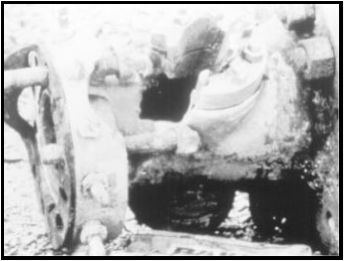
Figure 1.2 Surface Choke Failure Due To Erosion By Formation Sand (Source:
Completion Tech., 1995)
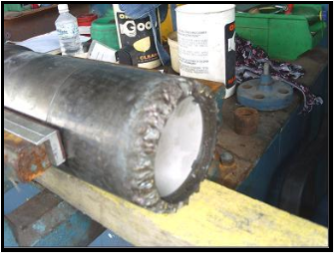
Figure 1.3 Eroded Piston Head (Source: Han Et Al., 2011)
1.2.1.2 Formation Subsidence
The impact of producing sand formation, it can collapse the formation. As time goes by, a tremendous amount of sand will be generated, which will be creating a void at the casing. As more and more sand is produced, it will be made the void larger and larger.
Furthermore, the void will collapse into it. Thus it decays the material. Most importantly, sand grains will create a lower permeability in the formation with a wider area of grain sizes. It will lose the productivity of the sand production.
1.2.1.3 Sand Accumulation In Surface Equipment
Reservoir fluid will carry the sand up to the surface, with higher velocity production in the fluid. However, sand particles frequently inhabit in the facilities such as separators, heaters, pumps, and condensers. Plus, it will accumulate in these facilities, it is a must to be cleanup from time to time.
Meanwhile, it will delay the production, and the well must shut down, and extras cost needed to be clean up the wellbore production. Production volume of the separator will decrease if it filled with sand. Similarly, it cannot handle gas, oil, and water.
1.2.1.4 Sand Disposal
It constitutes a problem in formations producing sand especially in areas where there are stringent environmental constraints. Offshore processing systems that do not satisfy anti-pollution regulation the separated sand is to be transported onshore for disposal constituting additional production cost.
1.2.2 Causes Of Sand Production
Rock strength and fluid flow are the elements that are affecting the factors that are affecting the tendency of the formation and the wellbore. Thus, sand particles consist of fine grain-size and load bearing solids formation in the production. Production rates are usually maintained at a consistent level so that it can avoid the production of the load bearing particles, but causing the production rates low.
1.2.2.1 Production Rate
Higher the fluid of the pressure near the wellbore, thus the rate of production will be increasing, which will move the sand into the wellbore. Consequently, pressure differential and frictional drag forces will surpass the compressive strength in the reservoir.
However, for wells that below the pressure differential pressure and frictional drag forces is not strong to exceed the exceed the compressive strength of the formation, therefore it causing sand production rate reduce. In order, to reduce the productions rate, it needs to slow it down at certain levels. So that, the flow rate will be within the acceptance range of the production of the well.
1.2.2.2 Pore Pressure Reduction
When the reservoir fluid in production diminishes, it causes the pressure and pore pressure to reduce. As it reduces, the production of the well will slowly deplete. Hence, by decreasing the pressure will generate the stress at the formation sand, it will make the overburden pressure to be increasing.
Moreover, formation sand particles may be crushed or break loose from its matrix at some time in reservoir life which could be produced along with the reservoir fluids. The formation might subside if the effective stress exceeds the formation strength due to compaction of reservoir rock from the reduction in pore pressure.
1.2.2.3 Increasing Water Production
When the water cut increased, sand production will increase as well. These occurrences can be explained by two mechanisms. Each sand grains were surrounded by the surface tension of the connate water, which are the cohesiveness to certain grains in the water wet sandstone formation. Besides, when the surface tension forces and the cohesiveness of grain-to-grain are reducing.
Alternatively, the productions of the connate water will be produced. The stability of the sand arch perforation has been shown to be limited greatly by the production of water resulting in the production of sand.
Whereas, an arch is a hemispherical cap of interlocking sand grains that is scheduled at constant drawdown and flow rate preventing sand production (Jon Carlson et al., 1992). A second mechanism by which water production affects sand production is related to the effects of relative permeability. As the water cut increases, the relative permeability to oil decreases.
This result in an increasing pressure differential being required to produce oil at the same rate. An increase in pressure differential near the wellbore creates a greater shear force across the formation sand grains. Once again, the higher stresses can lead to instability of the sand arch around each perforation and subsequent sand production (Completion tech., 1995).

Figure 1.4 Geometry Of A Stable Arch Surrounding A Perforation (Source: Completion
Tech., 1995)
1.3 Objectives
The main objectives of this research are:
- To explain the properties and importance of sand control required in bottom-hole production.
- To analyze the effectiveness of chemical additives in sand control.
- To evaluate the effectiveness of clay-sawdust as a possible sand control material in the petroleum industry.
1.4 Problem Statement
- How to increase the fluid velocity of the sand produced and increase the productivity of the sand production?
- How to determine the suitability of chemical additive in sand control?
- How can plastic consolidation be custom engineered and manufactured in accordance to oil sands reservoir properties for optimal sand control?
1.5 Scope Of Study
To complete the final year project, the student is required to complete the final year project titled Evaluation of Clay-Sawdust Mixture in Sand Control Application. This project requires the fulfilment of few objectives of study that requires the student to learn the properties and importance of sand control required in bottom-hole production.
The scopes of study that will be covered in this paper include several aspects:
- To explain the properties and importance of sand control required in bottom-hole production.
- To analyse the effectiveness of chemical additives in sand control.
- To evaluate the effectiveness of clay-sawdust as a possible sand control material in the petroleum industry.
- To analyse the type of clay that found in the sand control
- To evaluate the alternate sand control method for sand production consolidation by injecting the chemical additive that will be ideal for the reservoir well.
1.6 Thesis Outline
The thesis is divided into five chapters. Chapter one gives an introduction and problem facing during production. It also states the objectives and defines the scope. Chapter two talks about literature review on the subject matter sand control selection, chemical sand consolidation, in situ formation consolidation, resin coated sand consolidation, permeability and porosity of reservoir. The methodology is discussed in chapter three. Chapter four focuses on results & discussion. Chapter five gives conclusions and recommendations of the thesis.
CHAPTER II
LITERATURE REVIEW
2.1 SAND CONTROL SELECTION

Figure 2.1 Sand Control Type
Many unconsolidated heavy oil and bitumen reservoirs require a sand control screen system to prevent sand particle influx into the wellbore to minimize surface casing erosion and environmental and remedial costs. It needs to justify the problems which related to the downhole sand control system and prediction the desired amount of the production rate in the reservoir of sand would produce.
Sand production can be a significant issue when producing from unconsolidated reservoirs. Hydrocarbon production from unconsolidated sandstone reservoirs can plague with potentially erosive but mostly of the sand production. However, it will affect the movement of the formation sand causing it to re-orientation of the stresses and fluid velocity
The selection of the sand control method to be used in a reservoir depends on conditions of the reservoir field and economic considerations. Additionally, to determining which sand control techniques are suitable for the field. There are many different sand control methods each with pros and cons. Such as,
- Rate control or exclusion
- Non-impairing completion techniques
- Selective perforation practices
- Screens (without gravel packs)
- Slotted liners
- Wire-wrapped screens
- Premium screens
- Expandable screens
- Pre-packed screens
- Gravel packs
- Frac packs
- Chemical sand consolidation
- In situ formation consolidation
- Resin coated sand or gravel consolidation
2.2 CHEMICAL SAND CONSOLIDATION
In chemical sand consolidation, there is two type of method. utilised It is being used where the possibility and size of the sand production are considered low and is one of the preventive technique to pumped before sand production initiated. The latter is considered as more of a remedial technique in the increasing sand production. Chemical consolidation is mostly being used in a short, perforated intervals.
2.2.1 IN SITU FORMATION CONSOLIDATION

Figure 2.2 In Situ Formation Consolidation
In situ formation consolidation, it utilises by injecting resins liquid into the formation through the perforations and a catalyst is required for hardening. It will harden and forms a consolidated mass of the sand grains which sand grains will bind together at the contact points and increase its unconfined compressive strength. Certain catalysts are mix into the resin at the surface. Hence, it needed time and temperature to harden the resin.
In this treatment need to be considered to performed through all the perforations, thus after the treatment, the well will be permeable and consolidation might not deteriorate with time. However, it can increase the compressive strength of the formation, so it will be sufficient to withstand the forces while during the production of the flow rates.
Similarly, a suitable cementing job is a must for this method because to prevent the resin from channeling the casing. On the contrary, the perforation should not be treated at shaley zones because of the low permeability, and it is hard for the fluids to flow in place.
In situ formation consolidation leaves the wellbore fully open. It is important where large outside diameter downhole completion equipment is needed. While in situ formation can be done through tubing or in wells with small diameter casing.
2.2.2 RESIN COATED SAND CONSOLIDATION
There is two different way of injecting resin coated sand consolidation down the well and into the perforation. So that, it will maintain the sand surface. Thus sand pack will be bind together as the resin coating become harden. Some of the sand left in the casing after the operation. Whereas, this method needs to be perforated in order, to clean out the sand and controlled the flow rate.
Besides, resin coated include pumping sand into the well to filled the perforation and casing. Although, bottom hole temperature of the well will be causing the resin to complete the cure into a consolidated pack.
After that, sand consolidation packs able to drilled out the casing and leaving the resin coated sand in the perforations. Some of the remaining in the consolidation will act as a permeable filter to prevent the production of the sand formation, the uses of the resin coated are to prepacked sand screens.
Despite, using resin coated can be complex. First, and most important, it requires that all perforations be filled completely with the resin coated sand, and the sand will cure. The perforations increasingly, as zone length and deviation from the vertical increase. Secondly, the resin coated with sufficient compressive strength. Nevertheless, it has poor longevity, as most wells do not produce sand free for extended periods of time.
2.3 PERMEABILITY OF RESERVOIR
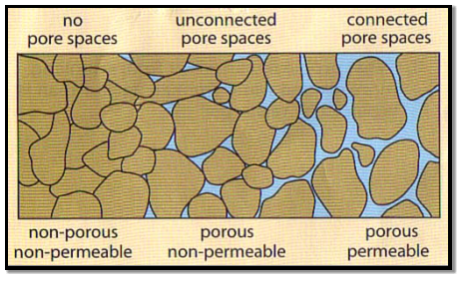
Figure 2.3 Permeability
Absolute permeability is the resistance to fluid flow in a porous media when it is the only fluid phase present. The permeability is a measure of the ability of the reservoir rock to transmit fluid. It is the conductivity of the reservoir rock (Gates 2012).
If it takes a lot of pressure to squeeze fluid through rock, that rock has “low permeability”. If fluid passes through the rock easily, it has “high permeability”. Permeability is measured in the unit of milli darcy (one milli darcy is 1/1000 of a Darcy). The rate of oil and gas can decrease if there are decreases in permeability of reservoir sands. Interstitial water and clay content are what contains in reservoir sand. (Jiang, et al., November 10, 2010)
Find Out How UKEssays.com Can Help You!
Our academic experts are ready and waiting to assist with any writing project you may have. From simple essay plans, through to full dissertations, you can guarantee we have a service perfectly matched to your needs.
View our academic writing services
After drilling progress in initiated the production of oil, water will infiltrate into the sand from drilling mud. The water will have less salinity compared to the pure original water. Swelling of clay particles is caused by the fresh water. Influence of driving pressure porous medium is a measure of the ease with which fluids may pass through the medium. The equation by which permeability to liquids may be calculated by laboratory measurements is:
 (Equation. 2.1)
(Equation. 2.1)
This equation gives permeability, k, in Darcy’s if viscosity, u, is expressed in centipoises; the rate of flow, Q, in cubic centimetres per second; length, L, in” centimetres; area, A, in square centimetres; and pressure differential, P1–P2, in atmospheres. This equation, known as Darcy’s law, is also used to calculate gaseous permeability if the volumetric rate of flow is measured at mean pressure.
There will be no reactions between the flowing fluids because it is one of the limiting conditions for the constancy of permeability. Swelling when wetted with waters is due to the clay contain.
2.4 SAWDUST
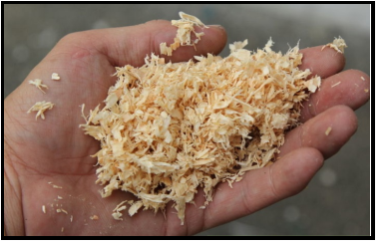
Figure 2.4 Sawdust
Sawdust is a tiny-sized and powdery wood waste produced by cutting, grinding, drilling, sanding and slicing wood with a saw or other tools. The size of sawdust particles depends on the types of wood, which the sawdust is collected and the size of the saw teeth.
Besides, sawdust is an effective, low-cost absorbent, which is widely used in many industrials. In addition, sawdust being essentially a lignocellulosic material is not easily deteriorated but rather stable on recalcitrant in the environment, and rarely produces odour during its long-term biodegradation process (Terazawa et al., 1999; Zavala et al., 2005).
Furthermore, benefits of using sawdust as a composite material are because it has desirable physical properties. Such as low apparent specific gravity(density), high porosity, high water retention, moderate water drainage, high bacteria tolerance, and biodegradability at an acceptable rate. For instance, sawdust composting process can be enhanced.
2.5 CLAY
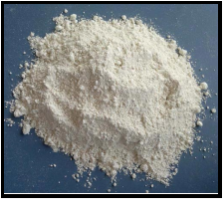
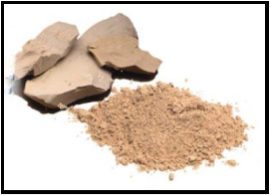
Figure 2.5 Kaolinite Clay Figure 2.6 Montmorillonite Clay

Figure 2.7 Illite Clay
Clay is a fine textured earth, it is plastic when wet but hard and compact when dry. It being referred to as finest grain particles in a sediment, soil, or rock. Clay is a very fine-grained, unconsolidated rock matter, which is plastic when wet, but becomes hard and stony when heated. It has its origin in natural processes, mostly complex weathering, transported and deposited by sedimentation within geological periods.
Clay is composed of silica (SiO2), Alumina (Al2O3) and water (H2O) plus appreciable concentration of oxides of iron, alkali and alkaline earth, and contains groups of crystalline substances known as clay minerals such as quartz, feldspar and mica.
The majority of the oil and gas reservoir contains clay. Thus, these clay minerals such as montmorillonite, illite, and kaolinite mostly found in the rocks of oil and gas exploration. In the early age of oil exploration, clay minerals were studied to predict the quality of organic rick source rock and generation mechanism when scientists tried to investigate the origin of oil and gas (Grim, 1947, Brooks, 1952).
At the same time, clay minerals were extensively analyses for diagenesis and reservoir quality prediction due to the application of petrological analysis and quantitative mineralogical analysis by X-ray diffraction (Griffin, 1971; Pettijohn, 1975; Heald and Larese, 1974; Bloch et al., 2002). On the other hand, it is important in oil sands. The particles will form adjacent to sand grains, and it will be occupied by the interstitial water found together with oil sands.
However, the cohesion of clay is larger than granular soils. Clay is less permeable than a sandy soil, and low water drainage. Hence, the pore pressure induced by an increase in load is dissipated very slowly, and the transfer of stress and the corresponding increase in inter-granular pressure are likewise much slower. The dispersed of clay is free to travel within the reservoir thereby becoming mobile clays which can cause plugging of pore spaces due to migration.
Therefore, deflocculation can occur due to low salinity-high pH, and natural repulsion forces due to not enough cations available. Once deflocculated, clay tends to migrate when the wetting phase becomes mobile. In addition to this, Clay swelling can be due to a ‘salinity shock’, where high salinity fresh water is introduced in a reservoir rock causing a ‘shock’ to the system.
Besides, montmorillonite clays can become mobile and then migrate causing issues with plugging of the pore space of a reservoir rock due to it being anionic charged can form thin microfilms on the surface of the sand control.
2.6 POROSITY OF RESERVOIR
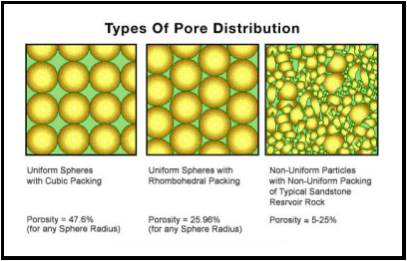
Figure 2.8 Porosity
The porosity of rock is a measure of the capacity of reservoir rocks to contain fluids. Oil, gas and water are within the reservoir rocks that fluids were stored in the pore space. Higher capacities of reservoir rock it contains fluids, it has high porosity. Whereas, low porosity has low capacities reservoir rocks fluids contain.
Therefore, porosity data are often employing qualitatively and quantitatively to determine and evaluate the potential volume of hydrocarbons contained in a reservoir.
For instance, in a discovery well that shows the presence of hydrocarbons in the reservoir rocks, the set of data that is reviewed at least qualitatively to evaluate reservoir potential is porosity data acquired with either logging-while-drilling tools or by running wireline tools.
These data are collected directly from the measurements of the core sample and well logs. It was to predict the reservoir characterization for the classification of lithological facies, and the assignment of permeabilities using porosity-permeability transforms. The porosity of rock is a measure of its capacity to contain fluids.
Porosity is calculated as the pore volume of the rock divided by its bulk volume.
ï¦ = 
ï¦ = porosity; Vp = pore volume; and VB = bulk volume. Pore volume is the total volume of pore spaces in the rock, and bulk volume is the physical volume of the rock, which includes the pore spaces and matrix materials (sand and shale, etc.) that compose the rock.
2.7FLOW RATE

Figure 2.9 Fluid Flow Through Wellbore
There is a critical fluid-flow rate beyond which the hydrodynamic force exceeds the binding forces holding fines particles together, and fines (<44 µm) begin to become fluidised. Not surprisingly, the flow rate through a sand pack can affect sand retention.
For instance, the lower the flow rate, the better the retention (Ballard and Beare 2006). Production can be affected by non-optimized inflow distribution. Drawdown and plugging can be affected by asphaltene and wax precipitation due to temperature reduction, the high viscosity of produced oil, resins present, near-wellbore pressure drop and flow convergence resistance created by the slotted liner (Trent 2005).
Additionally, multiphase flow increases plugging potential and sand control issues. By depending on formation characteristics and multiphase flow, the interstitial flow velocity can either enhance or reduce near wellbore permeability (Bennion et. al. 2008). When only one phase flows in a reservoir, then there can be an allowable increase in the flow velocity to the slot more than if there is multiphase flow.
Plugging and significant solids production occurs with the two-phase flow where water and oil flow since fines migration and transport only happens when the wetting phase is in motion in the porous media (Bennion et al. 2008). There is a critical fluid-flow rate beyond which the hydrodynamic force exceeds the binding forces holding fines particles together beyond which the fine started to move. A sudden increase in flow rate also could induce fines migration.
2.8SURFACTANT
Surfactant mostly uses in Enhanced Oil Recovery, and it is to improve the wettability of porous rocks allowing water to flow through them faster displacing more oil. Surfactant Flooding can improve oil production by decreasing interfacial tension, improving oil mobility thus allowing better displacement of the oil by injected water. (Chon, 2014)
The surfactant can be used to lower the amount of chemical usage in the recovery process, and it can decrease the chemical concentration to below 0.5 percentage. Surfactant provides safer enhanced oil recovery products at lower price. The most effective surfactant derived from plants are sunflower oil, soy and corn oil. These oils are no hazardous and non-toxic. (Hirasaki, et al., 2011)
CHAPTER III
METHODOLOGY
3.1 INTRODUCTION
The accompanying section clarifies about the technique utilized as a part of this exploration to assemble the important information. The information was to assess how clay-sawdust as a possible sand control material and could enhance by the surfactant for sand control applications.
3.2 CLAY
There is three type of clay which ha
Cite This Work
To export a reference to this article please select a referencing style below:
Give Yourself The Academic Edge Today
- On-time delivery or your money back
- A fully qualified writer in your subject
- In-depth proofreading by our Quality Control Team
- 100% confidentiality, the work is never re-sold or published
- Standard 7-day amendment period
- A paper written to the standard ordered
- A detailed plagiarism report
- A comprehensive quality report
Essay Writing Service
Essay Writing
Service
AED558.00
Approximate costs for Undergraduate 2:2
1000 words
7 day delivery
Order An Essay TodayDelivered on-time or your money back

1857 reviews

